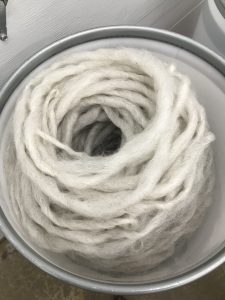This week at Olympic Yarn & Fiber I got to learn how to use one of the more important machines in the yarn creating process: the carder.
The carder is used to arrange the random, cleaned clumps of fiber into a parallel pattern that is even in thickness and cleaned of heavy guard hairs and vegetable matter. The Ramella carding machine that Olympic Yarn and Fiber uses is comprised of five different ‘workers’ or ‘flats’ that rotate on the base cylinder. The flats are made up of different small pin-like structures that rub in opposite directions to smooth out the fibers and cause them to lie flat. These diagrams from Fundamentals of Spun Yarn Technology by Carl A. Lawrence provide a great visual for the inner-workings of the machine:


For this particular project, we were processing three different types of wool: angora goat, llama, and alpaca. The client only wanted roving (the finished product of carding) for hand spinning so we were able to run all three wools in the same run. In order to keep them sorted and even, we weighed out 8oz portions of the wools and loaded the carder by that weight.
Here’s a video of the carder in action:
An important part of the carding process that I learned about was how to remove static from the lighter animal fibers. For the llama fiber and especially the alpaca fiber, Lynn had me “re-hydrate” them in order to reduce static. To do this, I spread out the fiber on a table, sprayed both sides, and massage the water evenly through the wool. This allows the wool to move through the carder smoothly and without sticking to itself.
A photo of the finished goat hair:
By the end of the process, we had carded about 9lbs of wool with only 6oz of waste. The waste was hardly waste, however, because the client is a hand spinner and able to spin from “the cloud” (a tuft of wool). Overall, it took us a little less than two hours to process the clients wool. After having my own experience with a drum carder (which took me 20 minutes to process an ounce on), I’m actually pretty amazed at the efficiency of the machine.
